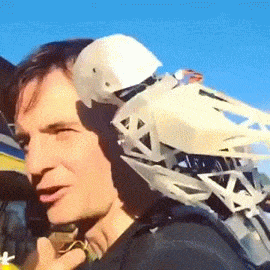 It’s amazing what motivation can do to further innovation. At some point, we humans are repeatedly frustrated enough to go out and invent something really cool, seemingly out of thin air. That is the perception with many 3D printed projects that seem like absolute magic, especially when you realize that one brilliant individual is capable of producing something so intricate and lifelike that it is almost eerie.
It’s amazing what motivation can do to further innovation. At some point, we humans are repeatedly frustrated enough to go out and invent something really cool, seemingly out of thin air. That is the perception with many 3D printed projects that seem like absolute magic, especially when you realize that one brilliant individual is capable of producing something so intricate and lifelike that it is almost eerie.The motivation for Jonny Poole at UK’s InnerbreedFX was in trying to create an incredibly lifelike, 3D printed animatronic lure for raptors that needed to be briefly captured for research reasons. The process of doing that is a lot of work, and there is currently a lot of wasted time and frustration involved in the process.
While Poole’s project was actually a labor of love, he was motivated to create the animatronic creatures after speaking with raptor specialists who explained the difficulty and frustration in trying to capture raptors for procedures like fitting them with leg bands for tracking purposes.
Capturing a raptor for research purposes must be done with the most absolutely humane and legal methods, but often that means that the actual humans must go to great lengths to figure out how to lure these grand birds of prey, like hawks. The current (and frustrating) methods employed by researchers are in making artificial lures or, after obtaining permits, using live animals that cannot be released into the wild.
Obviously, when you want to catch a wild animal, you must find the nest. If you don’t know that from real life experience or science class, you’ve probably clued in on it from every sci-fi movie featuring some sort of beast that must be captured. In this case, we’re just trying to capture unsuspecting raptors for the most positive of reasons and non-invasive procedures so that we can study them further.
In staking out the nest, the optimum lure for catching one raptor is in awakening its aggression by using another live raptor to draw him out and then net him, but that’s not always easy. The laws are very strict in the United States, and even more rigorous in the United Kingdom.
The easiest route for getting a lure out there immediately is, of course, to make something artificial with items featuring plastic lures, scarecrows, and lures with stuffed heads that swivel with controls. Poole wanted to make the entire process easier, and make something more believable all around, with the use of 3D printing and reference from taxidermy forms.
The movements that are important are ones that InnerbreedFX captured, such as cocking of the head, opening of the beak, and eventually, they will hope to include more complex spreading of the wings.
“I am certain that, if it was confirmed to work well, numerous researchers would be interested in forgoing the headaches of live lures and stuffed decoys by getting an animatronic. My goal is to successfully field test this idea,” said Jonny Poole of InnerbreedFX.
While it is possible to obtain a permit for a live bird that has been somewhat injured and is not going to be released back into the wild — the task is arduous enough that most researchers settle for making their own, and often that’s a pretty frustrating task in the making of the lure and then the sad results of not being able to capture the raptor. The other complication on top of attaining the permit to use a live bird as a lure is that the ‘bait’ has to be cared for and kept from harm, as well as any suffering from the elements.
 Poole points out that the lure needs to be streamlined, working, and non-invasive to the nesting area of the birds. Something very plastic and obviously foreign could upset the natural balance at the nest, defeating the purpose of an entire research program to begin with, as it is supposed to be promoting a positive study and outcome. Also, researchers often have to go far into rural and out-of-the-way areas carrying a lot of gear to work on these projects and to trap raptors for research, so the outcome needs to be productive after they’ve gone to so much trouble and hiked in with so much gear. The trap needs to work — and the lure needs to be as foolproof as possible, with as many lifelike movements as possible.
Poole points out that the lure needs to be streamlined, working, and non-invasive to the nesting area of the birds. Something very plastic and obviously foreign could upset the natural balance at the nest, defeating the purpose of an entire research program to begin with, as it is supposed to be promoting a positive study and outcome. Also, researchers often have to go far into rural and out-of-the-way areas carrying a lot of gear to work on these projects and to trap raptors for research, so the outcome needs to be productive after they’ve gone to so much trouble and hiked in with so much gear. The trap needs to work — and the lure needs to be as foolproof as possible, with as many lifelike movements as possible.
“Any of the armatures can be used with hand held radio controlled units or be set up to run a preprogrammed routine, along with an in-house ‘naturalization code’ that performs randomly ‘to give that unpredictable gesture that nature has,” said Poole.
The animatronic bird employs a Servo PullPull Tower, which is perfect for controlling the device. The unit holds up to eight servers and is about 6×7 inches high, with room for a control board inside.
Previous to all the amazing technology we have at hand, Poole was used to sculpting, molding and hand casting his projects. He taught himself how to use CAD software, and with the advent and accessibility of 3D printing, he is able to focus more on the creative and conceptual issues rather than the painstaking handcrafting.
We have reported on a somewhat similar and what now seems like a much more rudimentary 3D printed bird, with Brian Matthews’ 3D printed robotic parrot engineered with Arduino software.
Poole, a mechanical engineer, is used to being creative with parts, although 3D printing technology has made life a lot easier in the production process.
“If I can’t find a part I’m looking for on the market, I’ll make it. I then make these parts available for others to buy,” said Poole.
InnerbreedFX is a company focusing on freelance concept art and animatronics, 3D art and 3D modeling, as well as physical modeling, mechanical design, and illustration. Founder Jonny Poole is a mechanical engineer in design mechanisms and structures for high-end animatronics. Many of his projects include involve 3D printing.
I think everybody — researchers and everyone else too — will be clicking the like button for InnerbreedFX’s animatronic raptor. You will have tingles watching the video of the lifelike owl created through 3D printing and unrivaled creativity in taxidermy. Not only is this 3D printed creation purposeful, but it also displays the serenity and beauty of the animal in the quest to imitate. What do you think of Poole’s animatronic creations? Do the movements of his animatronic owl look lifelike enough to attract other birds of prey? Let us know your thoughts in the 3D Printed Animatronic Raptor Lure thread over at 3DPB.com.
Subscribe to Our Email Newsletter
Stay up-to-date on all the latest news from the 3D printing industry and receive information and offers from third party vendors.
You May Also Like
Themes from AM Investment Strategies: Collaboration, Cost Challenges, and Expanding Markets
The 2024 Additive Manufacturing (AM) Investment Strategies event went off without a hitch. The online roundtable, hosted by AM Research (AMR) and Cantor Fitzgerald, dug into the latest trends and...
Authentise Launches Generative AI Extension ThreadsDoc to Automate Document Creation
Manufacturing workflow software provider Authentise has announced its latest releases ahead of next week’s Formnext 2024 in Frankfurt. Building on its generative AI exploration, the startup is launching ThreadsDoc, a...
Supernova to Launch Viscous Materials and 3D Printer at Formnext
Ahead of Formnext 2024, Supernova has launched a new ecosystem for polymer additive manufacturing (AM), with the introduction of its proprietary Viscogels materials and the Pulse Production Platform. The ecosystem...
HP and Global Steel Giant ArcelorMittal Announce Strategic 3D Printing Collaboration
Fortune Global 500 company ArcelorMittal, the world’s second-largest supplier of steel, has announced a strategic collaboration with HP to develop new additive manufacturing (AM) applications for ArcelorMittal’s steel powders. Via...








































